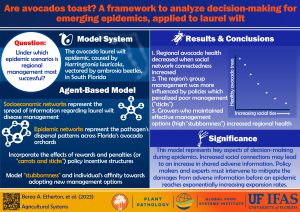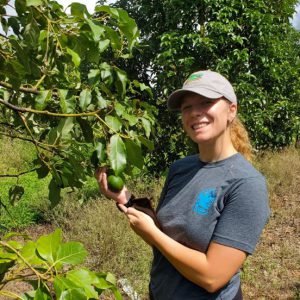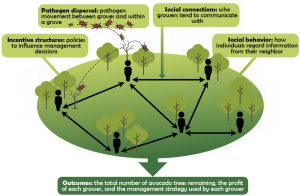A new epidemic begins to spread through a region densely populated with avocado groves – slowly, at first. Growers discuss management strategies with other nearby growers, and most of them agree that a wait-and-see approach is prudent. After all, drastic strategies come with drastic price tags. But as the epidemic surges, if growers are unprepared, the crop is devastated.
A simulated avocado epidemic is the basis for the recently published study, “Are avocados toast? A framework to analyze decision-making for emerging epidemics, applied to laurel wilt.”. The study, published in Agricultural Systems journal, simulates the effects of a laurel wilt epidemic on the avocado-growing community in southern Florida. One surprising outcome of the simulations was that increased social connectedness among growers led to a decrease in crop health. “At the beginning of an epidemic, the more people you talk to, the more people you’ll find who aren’t managing the disease,” said plant pathology graduate student Berea Etherton, lead author of the study. “Then disease starts ramping up.” Increased interaction between growers reinforced the selection of less expensive but less effective management choices, in these study simulations, especially early in the epidemic, “when the cost of disease management outweighed the cost of disease for many growers.”

The study also examined “carrot” and “stick” policy incentives for promoting collective action in managing the early stages of an epidemic. “Stick” policies, penalizing behavior that could worsen a region’s crop health, proved more effective than “carrot” policies, which reward behaviors that could benefit the region.

While the study is simulated, the implications are real. Homestead is the center of the avocado industry in Florida, the second largest producer of avocados in the United States, and a $54 million industry in Miami-Dade County. Laurel wilt was introduced to Homestead avocado groves in 2011. “It has just devastated Florida avocado production,” Etherton said. It hasn’t reached avocado-growing regions of Mexico and California yet, according to Etherton, but “it’s just a matter of time. If [the producers] don’t take the necessary steps to protect and address laurel wilt disease, it can be absolutely devastating.”
“Through simulating epidemic outcomes, we can identify the best-case scenarios for mitigating disease in these regions,” Etherton said. “By seeing the worst-case scenarios and best-case scenarios, we can understand how to help these growers make the best of the situation.”
 2
2
